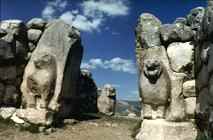 The city of Hattusas was founded on the site of an earlier settlement in about 1900 BC, soon gained importance owing to the presence of a Karum (market) or colony of Assyrian merchants. During this time, the Hittites had preserved memories when their kings had ruled from a city called Kussara which has not been located yet.
The city of Hattusas was founded on the site of an earlier settlement in about 1900 BC, soon gained importance owing to the presence of a Karum (market) or colony of Assyrian merchants. During this time, the Hittites had preserved memories when their kings had ruled from a city called Kussara which has not been located yet.
Around 1800 BC, one of the early kings, Anittas, began to extend his dominion by conquering first the city of Kanesh (Kayseri province), then Hattush. He seems to have transferred his government to Kanesh. Hattush, on the other hand, was destroyed and declared accursed. Between Anittas and the foundation of the Hittite kingdom there is a gap of several generations. Then the policy of expansion was continued by another king of Kussara, Labarnas, whose son another Labarnas, decided to rebuild and occupy Hattush - a natural stronghold domination the northern valleys. The city was thereafter known as Hattusha. This king was the true founder of the Hittite kingdom. Hattusha was the chief power and cultural force in West Asia from 1400 to 1200 BC. The city was sacked again in about 1400 BC by invaders from the north and east. However, in the early 14th century BC, Hattusas was rebuilt and enlarged by Suppiluliumas, the Great King of Hatti.
It remained as the capital for more that 200 years before falling due to internal pressures and invasions from the outside. Only two parts of the city were ever re-inhabited, Büyükkaya and the early citadel rock of Büyükkale. They were re-inhabited by the Phrygians.
The site of Hattusas or Bogazköy is strategically placed in rocky terrain at the head of a broad and fertile valley. The older part of the city occupies a spur of the hills above the modern village of Bogazköy towards the high citadel rock, Büyükkale at its southeast end, to which ancient walls are connected. In the 14th century BC because of the rising importance and size of the capital, the fortifications were extended over the high ground to the south to include a total area of over 300 acres. A century later, the hill called Büyükkaya to the east was also enclosed and connected to the old city by a bridge. The new walls to the south were of remarkable strength and sophisticated design. On the foundations brought to a consistent level by stone-faced ramparts with outer curtain walls and sally-ports. Tower-flanked gateways with arches were ornamented with sculptures.
In the town, remains of five temples have been recognized. Temple I is the most impressive and gives us an idea of the Hittite religious life.
Although the Hittite Empire vanished thousands of years ago, it has by no means been forgotten, and its capital Hattusha has been declared a World Heritage Site by UNESCO. Moreover, an enlarged copy of a cuneiform tablet found here hangs in the United Nations building in New York. This tablet is a peace treaty concluded between the Hittite king Hattusili III and the Egyptian pharaoh Ramses II about 3300 years ago, demonstrating to modern statesmen that international treaties are a tradition going back to the earliest civilizations.
Nearby Hattusas you can also visit the sites of Alacahöyük and Yazilikaya, other important Hittite sites in the area.

